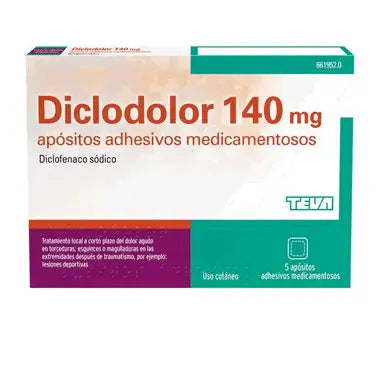Dressings for the symptomatic relief of acute pain associated with sprains, strains or bruises to arms and legs as a result of injury.
Contains 5 dressings.


Diclodolor is a medicated adhesive dressing used for the relief of occasional pain from minor bruises, contusions or sprains, as well as sports injuries.
It comes in a handy pack of 5 dressings.
Suitable for use by adults and adolescents over 16 years of age.
The dressings measure 10 x 14 cm and cannot be divided.
Diclodolor medicated dressing can be applied twice a day, ideally 1-0-1, i.e. in the morning and at night. Only one area should be treated with one dressing, i.e. if there are several lesions, they should be treated one at a time, not at the same time.
After 7 days of treatment, a doctor should be consulted if there is no improvement.
The use of Diclodolor is contraindicated in the following cases:
Diclodolor may cause side effects, as is the case with all medicines on the market. In this case, the following have been observed:
Each Diclodolor dressing contains 140 mg diclofenac diethylamine. The other excipients are:Glycerol, Sorbitol liquid crystallisable (E-420), Carmellose sodium, Sodium polyacrylate, Propylene glycol (E-1520), Diisopropyl adipate, Copolymer methacrylate base (E-1520), Diisopropyl adipate, Copolymer methacrylate base (E-1520).butyl methacrylate base polymer, Disodium edetate, Macrogol lauryl ether (9 EO units), Levomenthol, Tartaric acid, Water, Tartaric acid, Sodium methacrylate (E-420)Sodium sulphite (E-221), Butylated hydroxytoluene (E-321), Dried potassium aluminium sulphate, Anhydrous colloidal silica, Light kaolin (natural).
If you have suffered a bruise or blow or have sustained an injury while playing sport, apply 1 Diclodolor dressing twice a day, applying dry heat to the area beforehand to promote the penetration of the drug.
If after a week of symptomatic treatment of the pain and inflammation of the affected area does not improve, you should see a doctor for a clinical assessment and adjust the treatment to each individual case.
If you have any doubts, you can consult our pharmaceutical team.